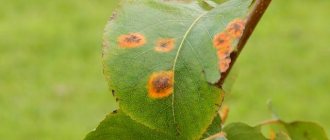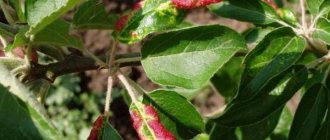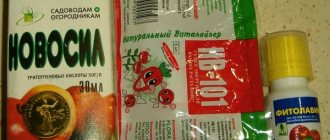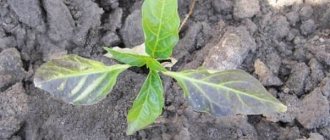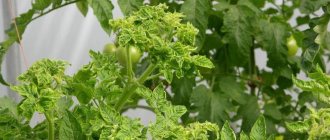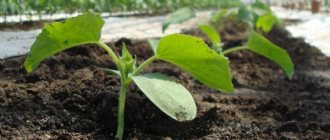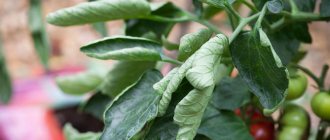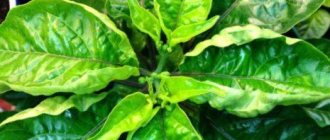Curling, drying out and falling of pear leaves is a common occurrence. It occurs for a number of reasons - perhaps the tree lacks nutrients or moisture, it is affected by a bacterial infection, fungus, virus, or pest. To determine exactly the cause of the problem, you will need to carefully inspect the tree.
In some situations, a single or double treatment using special preparations is sufficient. If you let the situation go, you will end up losing the harvest, deteriorating its quality, and killing the tree. In this review we will talk about the reasons for the curling of pear leaves, they will be described in detail and possible ways to solve the problem will be considered.
Why do pear leaves curl?
If pear leaves curl into a tube, there may be different reasons. Diseases and harmful insects can provoke this phenomenon. The main factors are considered:
- Nutrient deficiency. In some cases, a lack of useful elements can lead to curling of tree leaves and branches. It is recommended to pay attention to various fertilizers - perhaps they are applied irregularly or are not sufficiently balanced. The state of the crop is affected by a lack of boron, phosphorus, and calcium. Regular addition of complexes with missing elements to the soil will help to cope with this problem.
- Fungal diseases. Diseases caused by fungi often develop in humid and warm climates. The most well-known pathologies are scab, fruit rot, cytosporosis, various types of cancer, powdery mildew, and sooty fungus. Unfortunately, the causative agents of such diseases calmly wait out the winter in cracks in the bark of the tree, and in the spring (April, May) they begin to infect the plant. In this case, leaves, fruits, and branches can suffer. Only special medications will help cope with the problem.
- Bacterial diseases. Bacteria most often enter the tree with rain. In this case, both adult plants and very young ones suffer. The leaves curl and the bark becomes very dark in color and appears charred. The most common diseases are root canker and bacterial burn. This problem can be prevented by timely disinfection and treatment with special preparations.
- Viral diseases. Viral diseases are considered the most unpleasant. Initially, you may not even know that the pear is affected by them and is sick. However, after some time, the leaves begin to curl and fall off, and the fruits also suffer. The bark on the tree gradually softens, and the branches begin to break quickly.
Note! Unfortunately, it is almost impossible to cope with such diseases, so most often you have to dig up and burn all the plants. It is important to take preventive measures to prevent the development of diseases.
Diseases may be the reason why pear branches curl.
Diseases
Pear diseases are caused by viruses, bacteria and fungi. Those diseases that are caused by fungi manifest themselves in the form of plaque, rot, and spots. Pathogens spread with water, wind, and can be carried by insects.
Bacterial lesions appear as black, rotten, oily spots that subsequently cause certain parts of the plant to die.
Both bacteria and fungi can persist for a long time on plant debris and in soils, so it is important to promptly clean gardens and burn leaves and rotten fruits. Viral diseases are transmitted with the juice of a diseased crop through garden tools and insects
The main symptoms are ring spotting, mosaic, death of individual plant parts
Viral diseases are transmitted with the sap of a diseased crop through garden tools and insects. The main symptoms are ring spotting, mosaic, and death of individual plant parts.
Let's look at the main diseases:
- Scab is caused by Fusicladium pirinum. The leaves are affected, olive-colored spots with a velvety coating form on them, the fruits begin to rot, and their peel cracks. If young fruits are affected, they become deformed and pears grow asymmetrical.
- Fruit rot is caused by the fungus Monilia fructigena. The disease manifests itself as brown spots; over time, growths form that contain fungal spores. The wind can carry these spores throughout the garden and, accordingly, infect other crops. The pulp loses its taste and becomes loose.
- Sooty fungus - appears on the leaves in the form of a black coating similar to soot. The disease is caused by a fungal culture that especially loves weak plants suffering from a lack of microelements and nutrients. Over time, the soot fungus spreads to the fruit.
- Powdery mildew - its development is provoked by the Erysiphales parasite. The disease is easily detected by visual inspection, as it manifests itself as a characteristic white powdery coating. Affected inflorescences and leaves dry out and fall to the ground. Young crops are most susceptible to powdery mildew.
- Rust is caused by Pucciniaceae microorganisms. First, light yellow, and then orange, rather dark spots form. The fruits must be disposed of.
- Brown spot - the first signs of the disease appear during flowering, when olive spots appear on the upper side of the lower leaves. Then they turn yellow, become covered with plaque, and fungal spores begin to infect neighboring plants and leaves. Over time, all the green parts dry out.
- Mosaic disease - manifests itself in the form of white and green spots on fruits and leaves.
Red dots on pear leaves are usually a harbinger of rust, but there are other reasons - this article will tell you how to deal with them.
Mosaic disease spots can have different shapes and sizes; over time, the leaves change their original contours. Infected seedlings grow slowly and develop poorly, and wither away over time.
Insect invasion
Pear leaves curl and turn black: how to treat them
The appearance of certain types of insects can also cause problems with pear and apple trees. Pests disrupt the life processes in the tree, which leads to problems with leaves, fruits, branches, and bark. The greatest danger is posed by:
- Aphid. If there are ants on the site, then most likely there will be aphids. These small insects live on the leaves of the crop and feed on their juices. As a result, the leaves begin to hurt and may curl. Various chemicals will help control the pest.
- Pear copperhead. This insect not only harms the crop, but also provokes the development of sooty fungus. To prevent the problem, completely burn the fallen leaves. In addition, it is recommended to apply mineral fertilizers to the soil on time. You can prevent the appearance of copperhead by treating trees with organophosphorus substances.
- Mite. Ticks also feed on leaf sap. When affected by these insects, the leaves of the tree begin to turn black, their edges may curl, after which the foliage falls off. It is recommended to periodically thin out the plant and remove some of the branches; the cuts must be treated with special disinfectants.
- Leaf roller. The main problem is the larvae, which damage the tree and cause its death; the leaves can curl. You can cope with the leaf roller with the help of specialized drugs.
Aphids are a dangerous pest that affects crops
Important! When pests appear, treatment with preparations containing sulfur and phosphorus is required.
Fertilizing
You can prevent curling by applying timely fertilizers:
- Calcium. Due to its lack, the foliage begins to turn black, and the edges gradually curl upward. To prevent this, the pear needs to be fed with ash. 1 sq.m will require 3-4 cups of ash. The tree trunk is sprinkled with it, and immediately after this the pear needs to be watered so that all the nutrients reach the root system.
- Bor. It happens that with a lack of this element, the leaves on young seedlings begin to twist, and new branches stop growing and developing because all metabolic processes are slowed down.
- Phosphorus. From its deficiency, the lower leaves become small, turn black, curl, and then fall off. To eliminate this problem, you need to take 15-20 kg of superphosphate per 100 kg of manure and fertilize the tree with this product. If you feed superphosphate and manure separately, you will not get the desired result.
It is important to adhere to all agrotechnical measures. If damaged leaves are noticed on a fruit crop, they must be removed immediately. It happens that the circle of damage spreads to the branches; they also need to be cut off.
What to do if pear leaves curl into a tube
Apricot diseases: what to do if leaves curl and spots appear
If the leaves of a pear curl and turn red, you need to take action. After identifying the cause that caused the problem, it is necessary to treat the culture with special means.
Treatment with chemicals
Chemicals act quite quickly. They should be used in dry weather and prepared strictly according to the instructions so as not to harm the crop. The most popular and effective substances are:
- Horus;
- Bordeaux mixture;
- Raek;
- Speed;
- Kinmiks;
- Agravertine;
- Spark;
- Fitosporin;
- Topsin-M;
- Delan.
Curling of foliage can occur due to improper care
Note! Treatments are carried out the number of times indicated in the instructions - before and after flowering, in other periods. Otherwise, there will either be no result, or damage to the culture may occur.
Processing pears with folk remedies
Many people do not like chemicals, so they prefer to use traditional recipes. Such remedies are easy to prepare yourself, but they are also quite effective and help to cope with the problem. The most famous and effective are:
- Onion broth. Onion peels are used for various purposes. Solutions from this substance help cope with diseases and pests. It is necessary to pour water over the husks and boil for some time. After cooling, the solution can be used.
- Tobacco infusion. This remedy is also great for coping with problems that arise on the pear. The tobacco must be crushed and filled with water, left for a couple of days, and then used for its intended purpose.
- Potato infusion. An infusion of potato tops helps to cope with various dangerous insects. A kilogram of grass must be filled with water and left in a warm place for about 5 hours. Then grated laundry soap is added to the solution and the tree is sprayed with the resulting liquid.
- Dandelion decoction. Dandelions are not only weeds, but also an excellent pest repellent. The plants must be covered with water and boiled for about 20 minutes, then cooled and used for their intended purpose.
- Potassium permanganate solution. Potassium permanganate is an excellent popular remedy for treating any plants; it has disinfecting properties and helps get rid of pests and diseases. However, it is best to use it at the initial stage of the disease. To make medicine, take approximately 4 g of the substance per 10 liters of water. The leaves are sprayed with the prepared product and the tree is watered.
- Decoction with horsetail. This plant helps to cope with problems such as rust. A kilogram of grass will require ten liters of water. After infusing for 24 hours, it is necessary to boil the product for about half an hour, then filter and dilute with water. It is used for watering and spraying crops.
- Infusion of tomato tops. You can use tomato tops for autumn processing of the crop. To prepare the active substance, you will need to pour a bucket of water over the remaining plants and leave for a couple of days. Then strain and apply for spraying.
- Infusion of wormwood. Many insects cannot stand the smell of wormwood, which makes it possible to use it as a repellent. The grass must be filled with warm water and left for a day. The finished solution is poured into a spray bottle and used to treat pears.
Leaf damage must be treated promptly
Causes
An experienced gardener knows that the healthy color of apple tree leaves is dark green. Without any dots, color or shape changes. What if the leaves on the apple tree are curled? Why?
Causes:
- Lack of minerals (molybdenum, potassium, sulfur, nitrogen, manganese, magnesium);
- Pests;
- Diseases;
- Lack of moisture;
- Frostbreakers.
Are the leaves on the apple tree curling? This is a signal for action.
Determine the reason:
- Quickly eliminate mineral and moisture deficiency:
- Purchase the necessary mineral fertilizers and feed according to recommendations;
- We made adjustments to the frequency of watering - we began to water more often;
- And don’t forget about such agricultural practices as loosening the soil after watering and mulching.
- Pests need to be dealt with without delay. If you want to eat apples and not groan about lost time later. Take out the stored insecticides and treat according to the instructions. We will look at which ones to use below;
- With illnesses, show both patience and perseverance. After all, they did not appear instantly. In this situation, a set of disease prevention measures from spring to autumn (or from autumn to autumn) is more suitable. Exactly many diseases.
The urea solution will help heal the frostbite. Coat these places with a mixture of mullein and clay.
Complex of agrotechnical measures
Proper crop care will help prevent the development of diseases. It is necessary to carefully monitor the condition of the soil and apply the necessary fertilizing on time. The crop needs to be provided with proper watering, but at the same time ensure that there is no excess moisture.
On a note! Weeds interfere with the normal growth and development of the pear, so you should get rid of them in time. In addition, harmful insects often live and breed on weeds.
In summer, it is recommended to periodically inspect the tree crown and, if necessary, remove damaged shoots and leaves. You can also feed a pear through the leaf blades, because nutrients are quickly washed out of the soil.
If the leaves are curled, you need to take timely measures to treat the crop
Before wintering, plants should also be fed with various substances; it is better to burn fallen leaves.
Violation of the rules of care
The pear, although unpretentious, like any other garden crop, does not allow for improper care. She immediately reacts to mistakes during planting or growing. This is manifested by various signs, including curling of the leaves.
Frequent causes of this phenomenon are excessive moisture or dryness of the soil. It is necessary to check the soil and promptly respond to any deviation from the norm.
The condition of pear leaves is negatively affected by the abundance or lack of fertilizers. Loss of nutrients due to a heavy harvest weakens the tree and leads to dire consequences.
Crown pruning and hilling must be done very carefully. Any mechanical damage can lead to weakening and death of the tree.
The culture loves sunlight, does not tolerate close proximity to groundwater, and prefers fertile soils rich in organic matter.
Prevention measures
Preventative measures are also very important and help avoid curling of pear leaves. Such events include:
- regular treatments with special substances;
- constant spring whitewashing of trunks;
- compliance with the watering regime;
- using special baits to kill pests;
- regular pruning of rotten, damaged branches.
Compliance with the rules of care will prevent problems in the growth and development of the crop.
Useful tips and recommendations from experienced gardeners
Experienced gardeners recommend paying attention to pears all year round. It is important to carefully inspect the plant and take action at the first sign of damage or disease. At the initial stage, dealing with the problem will be much easier. The choice to use folk remedies or chemicals depends on the preference of the summer resident, but in some cases the problem can only be dealt with with the help of industrial preparations.
What to do if the leaves on the pear curl and turn purple? First of all, you need to determine the cause of the problem. After this, you should choose the right tactics to eliminate the disease or pests. With proper care, it is quite possible to avoid diseases and insect infestations. It is important to regularly inspect the crop and take the necessary measures in a timely manner.
How to prevent it?
To prevent the occurrence of diseases and pests, pear trees are regularly pruned. Sanitary pruning is carried out in the fall. All pruned branches are destroyed away from the site.
Several times a season, the area where pears grow is weeded and weeds destroyed. Regular feeding is also important. Organic and mineral fertilizers increase plant immunity. At the first signs of infection, you need to take immediate action. If you do not start treating the pear in time, you can lose not only the harvest, but also the tree. Many advanced stage diseases cannot be treated.
